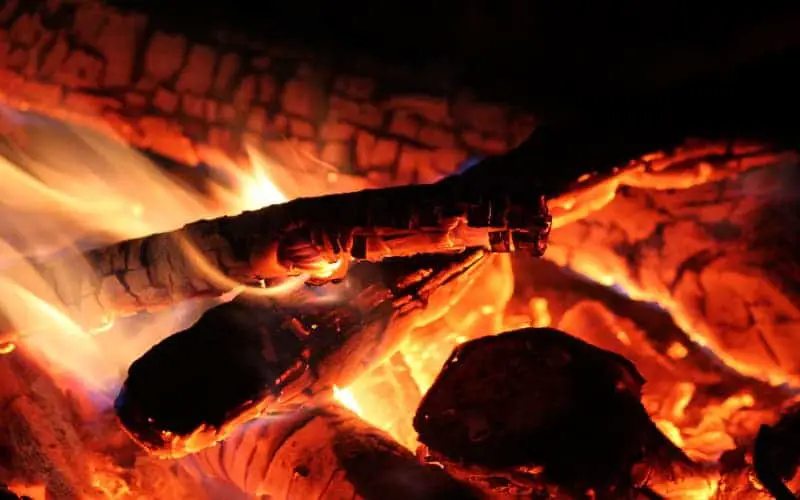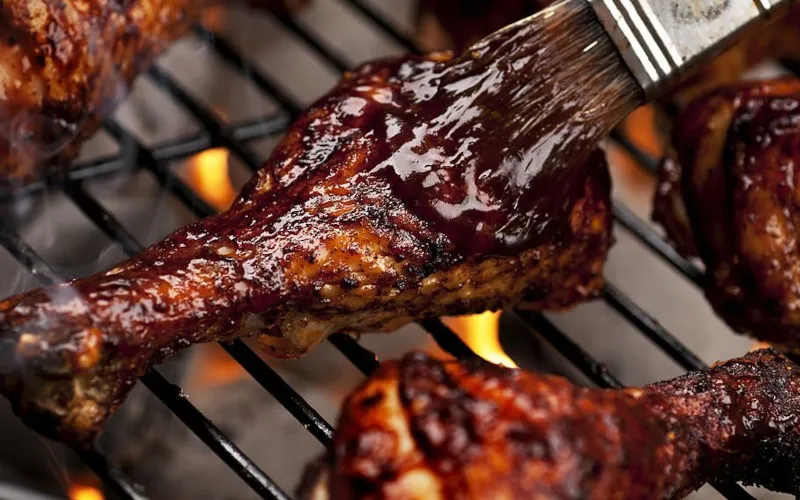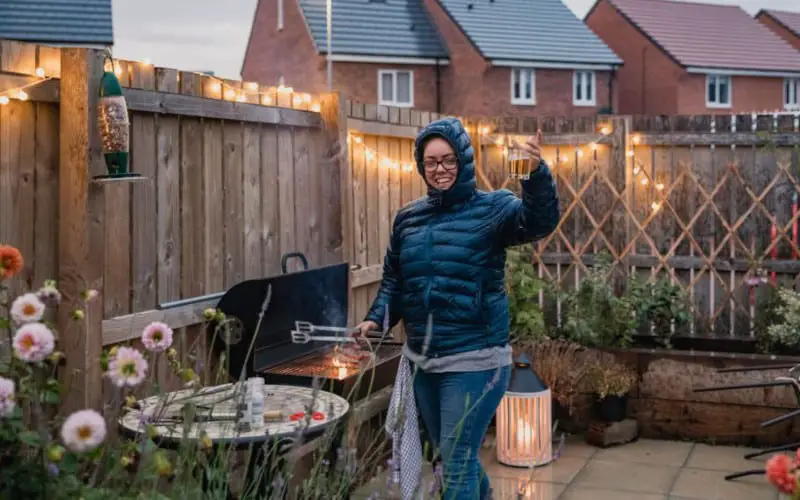Want to learn how to make charcoal?
This step-by-step guide is your answer.
We will cover everything you need for this DIY project, including what type of wood to use, the best tools for the job, and why it’s so important that you wait until after sunset before starting.
Get ready to start building up your supply of charcoal.
What is Charcoal?
The word charcoal comes from the Latin “carbo” meaning coal. Charcoal is a non-metal material that can be used to produce heat or energy.
It’s made by removing the moisture, combustible materials, and other impurities from animal bones, wood parts, food wastes (like banana peels), agricultural waste products like manure/hay, etc., coal mine tailings, charcoal kilns, or other carbonaceous materials.
When you heat the wood to the point that it’s reduced almost completely to charcoal (carbon), what remains is a flammable black solid with very little smoke and no sparks as compared to burning the original pieces of wood in their natural state.
This makes cooking over an open fire much easier because there is less smoke and it doesn’t require constant attention.
[humix url=”https://electricsmokerhq.com/humix/video/3h_PYAHBOWf” float=”1″ autoplay=”1″ loop=”1″]
What is Lump Charcoal?
Lump charcoal comes from a solid bit of wood that has been heated up. The process creates an even fire with very few embers.
This means the charcoals burn more evenly for grilling or cooking outdoors on hot days when other fuels would flare up too much in the heat of summer month’s weather conditions.
Lump charcoal is usually made from one of four different types of wood:
- Oak
- Hickory
- Mesquite
- Pecan
The type you choose will give your grill a distinct flavor. Mesquite has the strongest smokey taste, while pecan burns more mild and sweet-smelling than any other hardwood lump charcoals on the market.
What is the Best Type of Wood?
There are three main categories in which you can place charcoal, each one having its own unique characteristics and benefits: natural hardwood (oak), fruitwoods (apple), and softwoods (pine).
The best type of wood for making your own fuel sources are hardwoods found in maple trees and oak trees. These types will give off enough heat when they burn so as not to require soaking them with lighter fluid as softwood would need.
Natural hardwoods produce high-quality lump charcoal that has an intense burn time but is quite expensive. Softwoods burn slowly and give off a lot of smoke but are quite cheap compared to the other two types. Fruit woods fall somewhere in between both categories with an average burn time and price.
To start this DIY project, you’ll need a metal bucket (or some other container), an axe/hatchet, old newspaper, and twine.
What is the Process of Making Wood Into Charcoal?
The process of making wood into charcoal can be traced back as far as 10,000 years ago when humans learned to control fire through the use of stone-age technology such that they could cook their food over an open flame.
The main component in all things combustible — including coal gas used today by many people worldwide for cooking purposes — is carbon which provides fuel with its energy content while releasing heat from combustion.
In order to create this specific type of wood for combustion purposes, it is important to understand that the process must be executed properly, or else you’ll just end up with a bunch of useless charcoal.
For instance, certain types of wood may catch on fire easily and burn out too quickly, whereas others will not produce enough heat for combustion purposes.
It all depends on what type of fuel you’re looking for and of course, your personal preference.
The earliest-known method for creating charcoal was to burn the wood in a pile with air spaces between each piece, allowing oxygen to filter through more easily as it burned. This is still the most common type of procedure used today by people who make their own lump charcoal at home because they know what they’re looking for.
Although it may be easier to use wood already cut into smaller pieces, this doesn’t allow enough oxygen to pass through, which means your end product will fail in its combustibility (and therefore the amount of heat you’ll receive from burning it).
Tips For Making Quality Charcoal
If you want high-quality lump charcoal, then follow these steps:
- Cut your wood into thin pieces, around an inch in width, for optimal airflow. Wider cuts will work, but it’s not nearly as effective because the heat won’t be dispersed properly to ensure combustion. This step may take a while, so make sure you have time to complete this part of the process before moving onto something else, or you may have to start all over again.
- Place your wood into a metal container with an open top, separating pieces as much as possible so they do not touch or touch each other. The more airflow between the individual wood sticks means better heat generation upon combustion – this will also ensure its weight doesn’t smother it out.
- Place your wood container into a fire, but make sure it’s not too large, or else the heat won’t be distributed properly between all pieces – this will result in some burning while others remain untouched and unchanged. The smaller you can keep your flame source, the better because the wood is less likely to be smothered out.
- Keep your fire burning for a few hours, depending on how much you have to begin with – once it’s been reduced to around 50%, remove all pieces and place them onto some wire mesh (not metal because this will damage their surfaces) and separate each one as much as possible by hand.
- Move your pieces into a well-ventilated area – this means open air, but not outside in the rain or wind because it will blow away, and you’ll have to start all over again. Keep them out of direct sunlight as much as possible for several days until they become dry enough to handle with bare hands. If there is a bit of moisture in some areas, just hit them with a blow torch for a few seconds, and that should be sufficient.
- Once your pieces have been thoroughly dried by whatever method you chose (be sure not to burn them), they are now ready for storage or transport if you wish to sell the charcoal as part of an exchange. Remember to keep it in a well-ventilated place and away from moisture. Otherwise, your charcoal will catch on fire.
What are Charcoal’s Properties?
Charcoal has been an integral part of cooking for thousands of years because it burns at lower temperatures than most organic substances which makes it perfect for open fires where you need constant attention but not intense levels just yet.
You could say this about any fuel source though so why choose charcoals over others?
The answer lies in its ability to reduce smoky emissions when compared with something like wood or natural gas.
Charcoal is flammable and easily ignites when exposed to heat, flame, sparks, etc. It’s also extremely porous which means it has a lot of surface area for the gases that come out during its combustion process so you get better results over something like firewood because it contains even more combustible matter.
Charcoal is a very stable substance that’s most resistant to chemical changes and has been used as medicine for thousands of years because it absorbs impurities from the body which helps with detoxification, digestion, etc.
It also increases blood circulation so this could be one of its most common uses today if you choose to use it medically.
What are the Benefits of Charcoal?
Charcoal is used for a wide variety of purposes, but most commonly known as something you use to get rid of odors in your home or on your person.
It’s also good at absorbing moisture which makes it useful when drying things like wood without having to wait an extended period of time for it to dry naturally.
Charcoal is also used in water filtration systems because of its porous nature that allows the filter media to catch more dirt, bacteria, etc. than most other substances so this could be another use for charcoal if you’re looking to save money on an expensive carbon block system or just want a cheaper alternative to using on a temporary basis.
What are the Disadvantages of Using Charcoal?
Even though charcoals have been used for thousands of years, it’s not always necessary to use them because there are other substances that can do just as good of a job at producing heat or energy with less work required from you after they’ve been lit.
For example, if you’re using a gas stove to cook dinner then charcoal probably isn’t necessary because it doesn’t produce any fumes or smoke while burning and requires more work on your part once it ignited compared with natural gas which is ready for use as soon as the valve is open or the knob is turned.
What are the Recommended Safety Precautions to Take When Using Charcoal?
Charcoal produces carbon monoxide which you should never inhale, so make sure your grill or stove ventilation system works properly and that there’s a way for any gas vapors produced while burning to escape without coming in contact with open flames.
What are Some Alternative Fuels That can be Used to Produce Heat or Energy?
There are lots of different fuel sources available today, but the most common would have to be propane. It’s a gas produced by heating organic material like animal waste and this is then transported through pipelines as an inert substance until it reaches its destination.
Where Can Charcoal be Purchased?
You’ll find it at most grocery and hardware stores because people will use it for a variety of purposes like grilling, smoking, etc. If you don’t live near any of these types of shops then there are some online retailers that sell charcoals as well.
Is Charcoal Safe for the Environment?
Charcoal is considered to be a fossil fuel that is non-renewable because it can’t be produced in an unlimited fashion like most other substances available today, but this type of fuel does burn cleaner than others which reduces smoky emissions and pollution levels.
This makes it a good choice for those who live in areas with high air pollution and environmental conservation efforts, but it’s not as environmentally friendly as some other alternative fuels.
What is the Best Way to Store Charcoal?
Charcoal should be stored in a dry location that isn’t exposed to direct sunlight or moisture because this can reduce its effectiveness over time.
If you have a large bag of charcoal then it is recommended that you break this down into smaller bags that can be stored more easily in your home or garage without taking up too much room, and these should also be kept away from any open flames to avoid the risk of fire.
What are the Steps Involved With Making Homemade Charcoal?
You can make charcoal by burning organic material like wood, coconut shells, and even bones because these materials will produce a black residue after being exposed to extreme heat.
The process for making your own charcoals involves burning the material until they turn black and then removing anything that isn’t charcoal-like ashes and dirt.
Make sure you use a container that has an airtight lid or seal, such as a metal canister, or even just place it inside of aluminum foil, then punch some holes into the bottom of whatever material you’re using to allow air from the fire inside.
You can easily create charcoals at home by burning organic material like wood in an enclosed container or even coconut shells, but it’s recommended that you use a metal container to avoid any accidents due to potential fire hazards which could lead to injury or damage to your home.
Be sure to check out the steps above to get more detailed on how to make charcoal with wood.
What is the Biggest Mistake People Make When Making Their Own Charcoal?
Not having enough ventilation or allowing too much airflow can cause some homemade charcoals to burn excessively fast and even explode, so it’s important that you take the necessary steps required for proper ventilation during this process if you want your charcoal to turn out right.
What is the Biggest Mistake People Tend to Make When Making Their Own Charcoal?
People often add too much moisture or leave them in an extremely humid environment which causes them not to burn evenly and can even cause them to explode, so it’s important that you dry out any organic materials before attempting to make charcoal if you plan on using this method.
Conclusion
So now that you know what type of wood to use and which tools are best for the job, all you need is a little patience. You can’t rush perfection!
Wait patiently for your charcoal to cook and then enjoy them with friends or family as an alternative form of fuel.
Hopefully, we’ve given you enough information so that making charcoal doesn’t seem like such a daunting task anymore. Now go out there and make some beautiful black gold!





